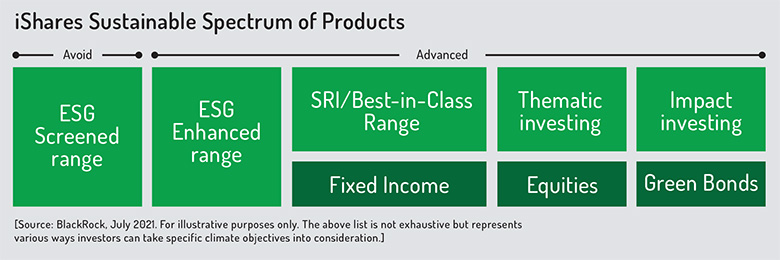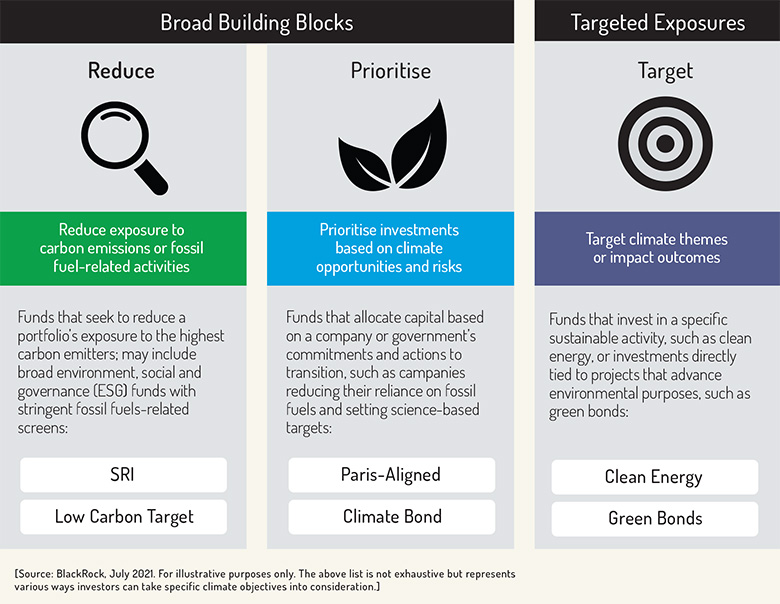Trustees already face a myriad of challenges and today, most schemes now face a timeline for compliance with various climate and ESG regulations, which vary by country, scheme type and scheme size. Meanwhile, the intensifying spotlight being shone by underlying scheme members on areas like climate, diversity, and stewardship, will continue to pave the direction of travel.
For professional clients only.
The growth and sophistication of the Sustainable indexing landscape has taken shape concurrently. As of June 2021, sustainable ETF assets are just above $270bn. For context, at the end of 2019 that number was $63bn, and so we have seen over $200bn in asset growth in just over a year and a half. [Source: BlackRock Global Business Intelligence and EPDR at 30 June 2021. Past flows into Global ETPs are not a guide to current or future flows and should not be the sole factor of consideration when selecting a product.]
Sustainable investing is certainly not a one-size-fits-all trend. Underpinning this asset growth lies an array of exposures than can help schemes meet sustainable investment goals such as Paris alignment, decarbonization or the improvement of specific ESG credentials. Focusing on specific parts of the sustainable transition, such as climate, has the potential to improve long term risk-adjusted returns.
This article explores the unique benefits of Sustainable ETFs and provides an overview into schemes can harness their power.
The Role of Sustainable ETFs for Pension Funds
‘Sustainable’ or not, ETFs provide investors with an efficient way to obtain low-cost, transparent exposure to a benchmark. Furthermore, ETFs have always offered a great deal of granularity to investors. They have enabled them to be more precise on an expressing country, regional, or thematic views.
Below, we expand on three key use cases by pension schemes across Europe who have adopted Sustainable ETFs:
1. Transition Management – Sustainable ETFs can serve as a transition vehicle for schemes who are seeking an interim solution prior to whilst building bespoke, long-term sustainable mandates. Schemes can also use ESG short duration fixed income ETFs to simply reduce drag from excess cash or even to facilitate capital calls into private markets.
2. Precision Exposure – The granularity of ETFs gives schemes an opportunity to integrate ESG across certain sub-asset classes. Growth fixed income stands out in the context of pension schemes, for example Emerging Market Debt and High Yield ESG exposures are now available. For those less concerned about tracking error to non-ESG benchmarks, SRI, Thematic and Impact ETFs also help schemes meet specific ESG objectives beyond basic screens and optimisation.
3. Climate – As climate considerations become more important to asset-liability management, schemes may want to consider aligning their portfolios with the transition to a low carbon economy. Paris alignment will be a key focus for schemes (and members) and BlackRock is committed to launching products with explicit temperature alignment goals.
“For investors, the risks of climate change go right to resiliency of companies in their portfolios,” says Remy Briand, head of ESG at MSCI. “Net zero is becoming increasingly important, both in terms of potential risks but also opportunities. The middle of the century remains nearly 30 years away, but the reallocation of capital and repricing of assets is already underway.”
Benefits of Sustainable Indexing for Schemes
Indexing puts you in control of what type of sustainable investor you want to be. There are now nearly 600 sustainable ETFs globally, up from around 30 a decade ago, and a growing number of which have climate-oriented considerations. [Source: BlackRock analysis of Morningstar global data; (as of Dec. 31, 2020)]

If we spotlight climate-aware options within this spectrum, at BlackRock, we have devised a framework for clients to either reduce, prioritise or target their climate exposure, dependent on their sustainability goals.

We outline four more reasons why sustainable indexing gives pension schemes the clarity they need to help build more sustainable portfolios:
1. Sustainable indexing aims to help provide a consistent approach across a portfolio.
As investors transition to sustainable investing, indexing may help to ensure sustainability is expressed in a consistent way across the entire portfolio. Indexes are inherently rules-based, so the screens and ESG integration they deploy are repeatable, regardless of asset class or exposure.
2. We believe sustainable indexing drives industry standardisation, promotes disclosure and seeks to help motivate better corporate behaviour.
We believe that indexing is bringing clarity to the sustainable investing space by providing transparency and accelerating the adoption of new market standards. Sustainable indexes will play an increasingly important role in directing capital flows to companies with the best sustainability practices and the most comprehensive sustainability disclosures. Companies that are dedicated to prioritising sustainability efforts aim to be better positioned to attract long-term shareholders, as they will have a higher weighting in the market’s new mainstream ESG indexes.
“Investors and policymakers are aligning behind the need for standardized measurements and a core set of quantitative climate disclosures,” Briand says. “If companies disclose a common, core set of climate data, investors will converge on the information they need to inform their decision-making.”
3. Sustainable indexes have shown resilience in difficult times.
During last year’s market dislocation, a majority of sustainable indexes exhibited resilience relative to broad market benchmarks. * We believe this is because sustainable indices are generally comprised of companies with higher profitability and lower levels of leverage than the broader market.
4. Index fund asset managers with active investment stewardship seek to drive long-term change.
Indexing amplifies the impact of company engagements because index investors typically take a long-term view. Those who are sustainability-minded can exercise influence with companies through engagements across environmental, social and governance (ESG) topics.
Implementation through a whole-portfolio approach
BlackRock’s Global sustainable Survey of September 2020 found 425 institutional investors planned to double their sustainable assets under management in the next five years to 37%. [Source: BlackRock Global Client Sustainable Investing Survey. July – September 2020.]
Respondents included 425 investors in 27 countries representing an estimated US$25 trillion in assets under management.
Despite the appetite to increase allocations, implementation remains a key challenge for investors. As an asset manager, we also need to have the right data in place to help asset owners undertake portfolio construction. Index and data providers like MSCI have played an important role in driving improvement and the quality and breadth of sustainable metrics.
Combining this with our Aladdin platform technology, we can help investors take a total portfolio approach to ESG integration.
This year, BlackRock also decided to reflect the impact of climate change into our CMAs, which are the cornerstones of the total-portfolio approach we adopt in building client portfolios.
While the momentum behind sustainability is remarkable, it is still the beginning of a long journey. An estimated US$50 to US$100 trillion in capital investment is required to rebuild a “net zero” global economy – one that emits no more greenhouse gas than it removes from the atmosphere by 2050. [Source: Intergovernmental Panel on Climate Change (IPCC), “Mitigation Pathways Compatible with 1.5°C in the Context of Sustainable Development,” in an IPCC Special Report on the impacts of global warming, 2018.] We expect sustainable indexing to play a crucial role in helping facilitate this reallocation of capital.
Capital at risk. The value of investments and the income from them can fall as well as rise and are not guaranteed. Investors may not get back the amount originally invested.
This material is not intended to be relied upon as a forecast, research or investment advice, and is not a recommendation, offer or solicitation to buy or sell any securities or financial product or to adopt any investment strategy.
Risk Warnings
Past performance is not a reliable indicator of current or future results and should not be the sole factor of consideration when selecting a product or strategy.
Changes in the rates of exchange between currencies may cause the value of investments to diminish or increase. Fluctuation may be particularly marked in the case of a higher volatility fund and the value of an investment may fall suddenly and substantially. Levels and basis of taxation may change from time to time.
Important Information
This material is for distribution to Professional Clients (as defined by the Financial Conduct Authority or MiFID Rules) only and should not be relied upon by any other persons.
In the UK and Non-European Economic Area (EEA) countries: this is Issued by BlackRock Investment Management (UK) Limited, authorised and regulated by the Financial Conduct Authority. Registered office: 12 Throgmorton Avenue, London, EC2N 2DL. Tel: + 44 (0)20 7743 3000. Registered in England and Wales No. 02020394. For your protection telephone calls are usually recorded. Please refer to the Financial Conduct Authority website for a list of authorised activities conducted by BlackRock.
Any research in this document has been procured and may have been acted on by BlackRock for its own purpose. The results of such research are being made available only incidentally. The views expressed do not constitute investment or any other advice and are subject to change. They do not necessarily reflect the views of any company in the BlackRock Group or any part thereof and no assurances are made as to their accuracy.
This document is for information purposes only and does not constitute an offer or invitation to anyone to invest in any BlackRock funds and has not been prepared in connection with any such offer.
© 2021 BlackRock, Inc. All Rights reserved. BLACKROCK, BLACKROCK SOLUTIONS, iSHARES, BUILD ON BLACKROCK and SO WHAT DO I DO WITH MY MONEY are trademarks of BlackRock, Inc. or its subsidiaries in the United States and elsewhere. All other trademarks are those of their respective owners. MKTGH0521E/S-1661665, MKTGH0921E/S-1824065-2/5’
© 2021 funds europe





